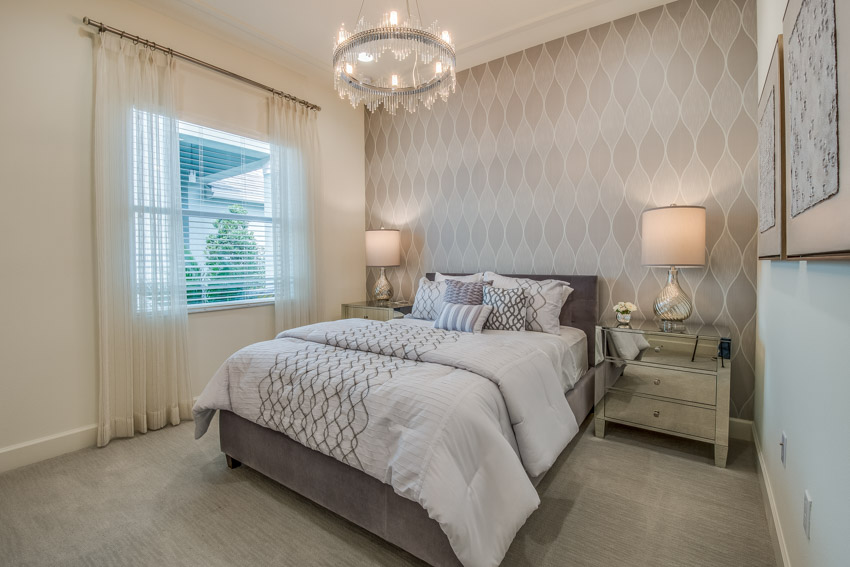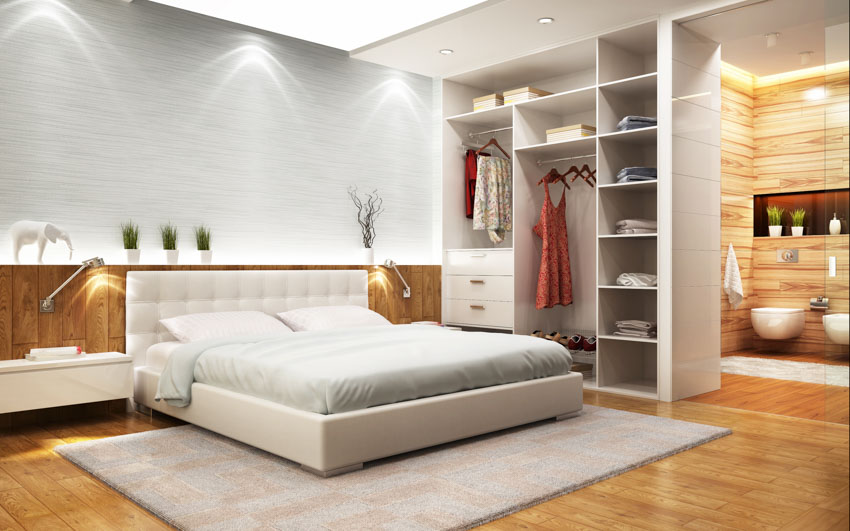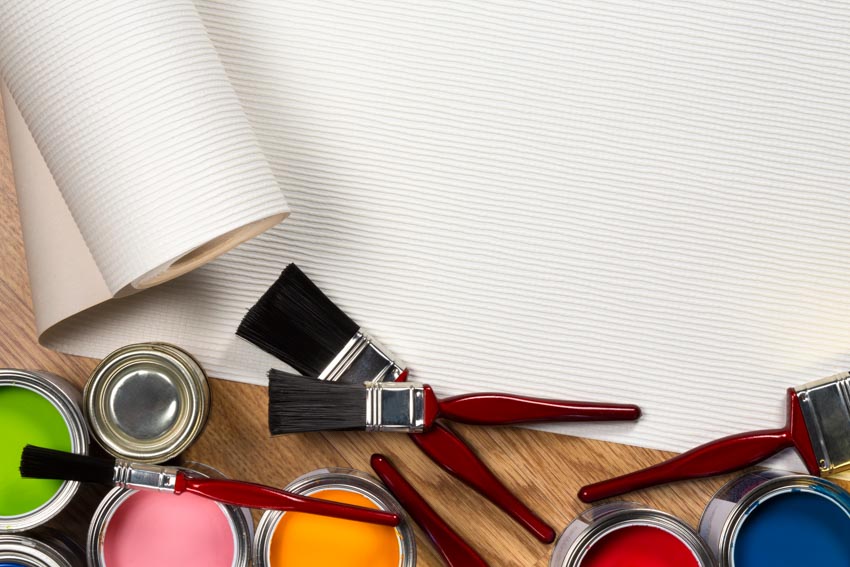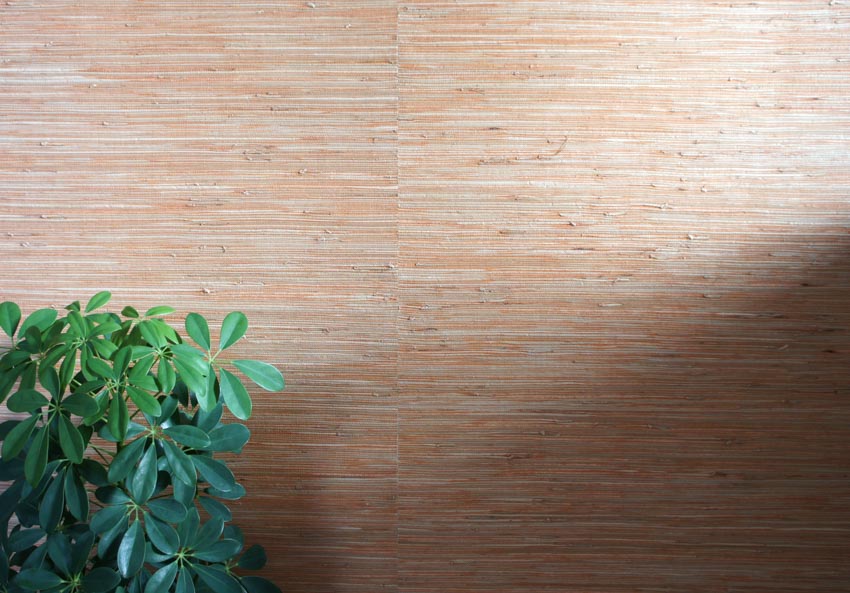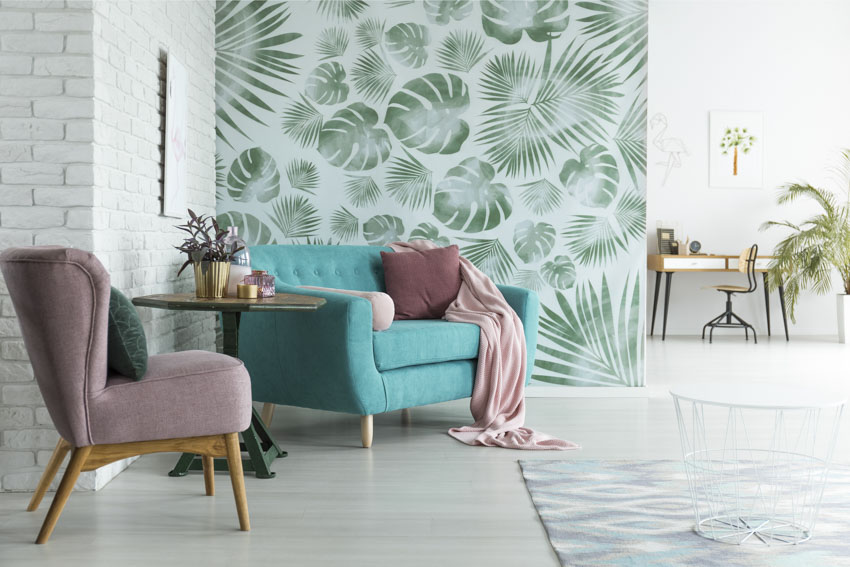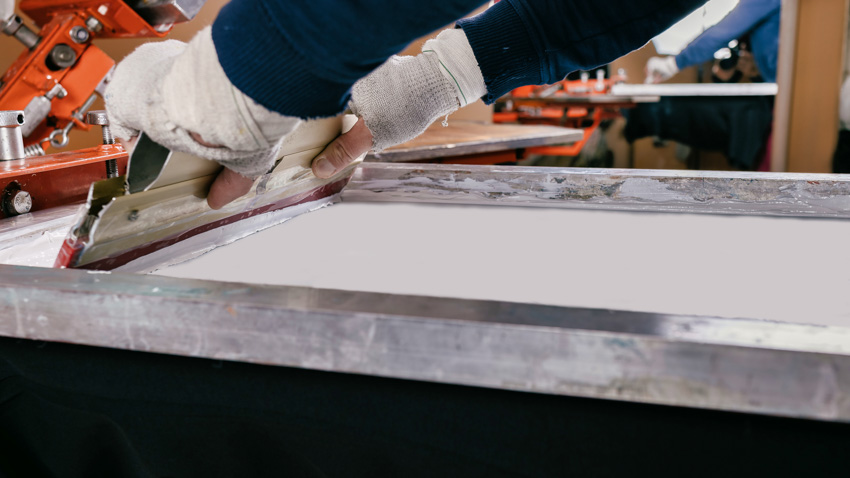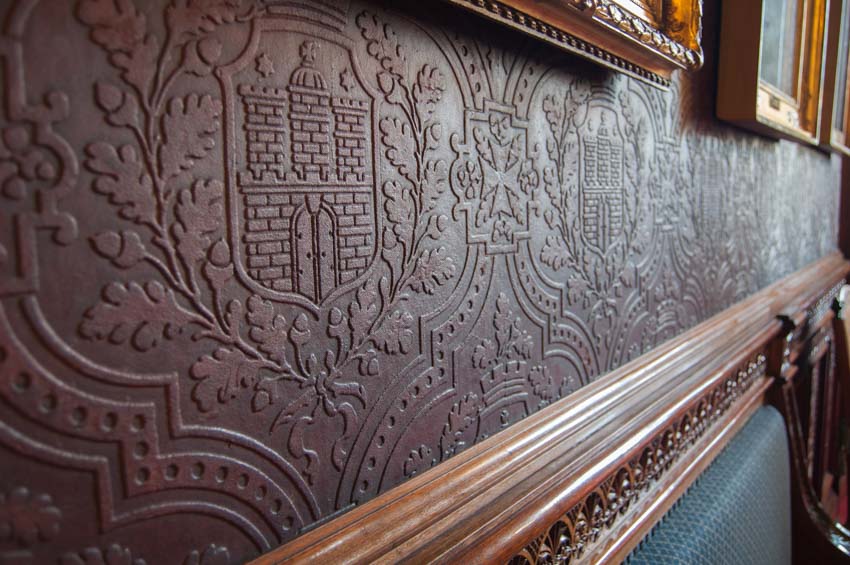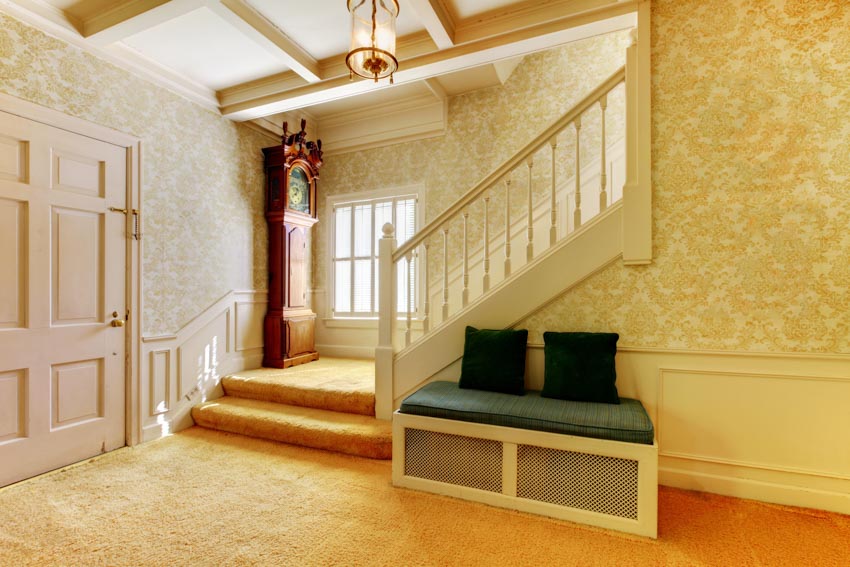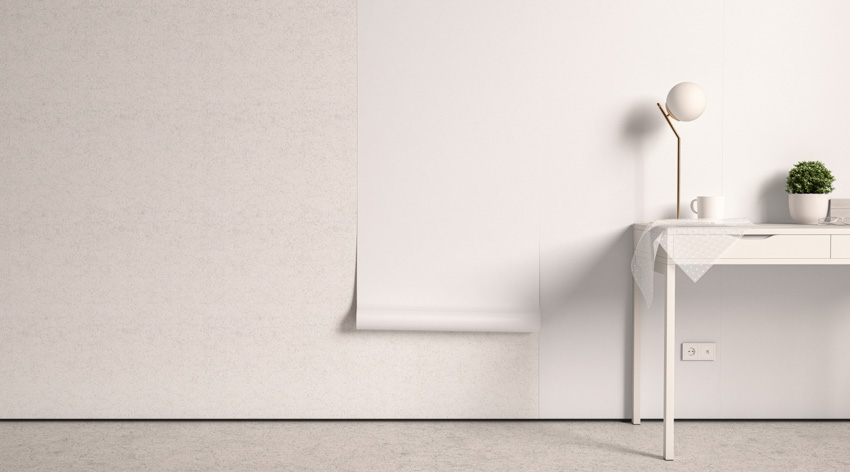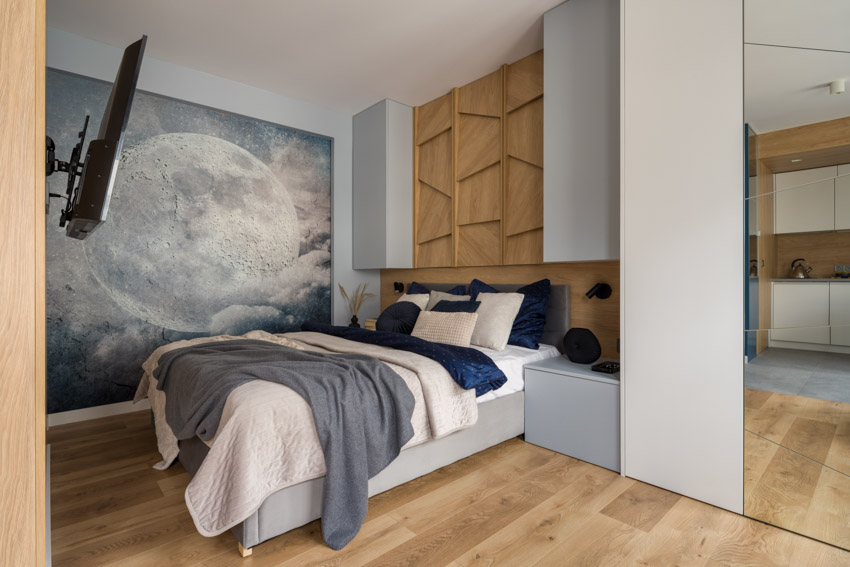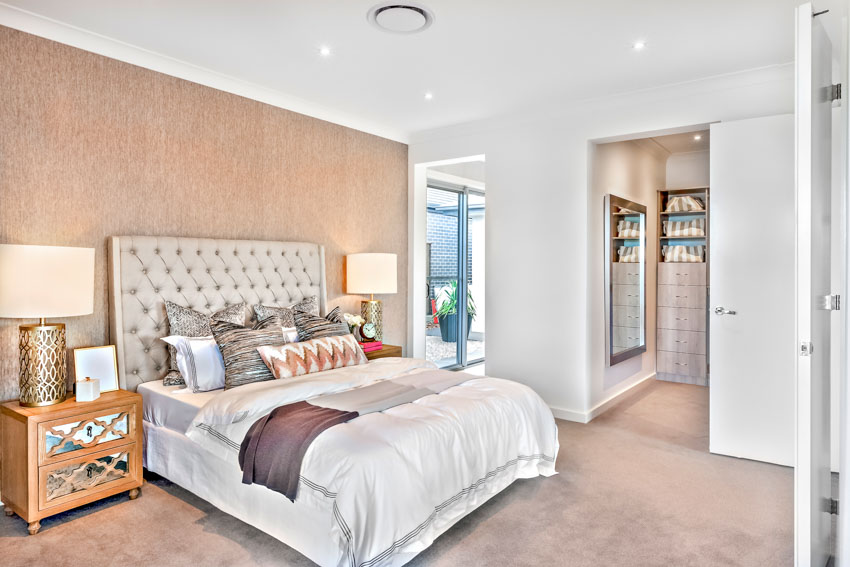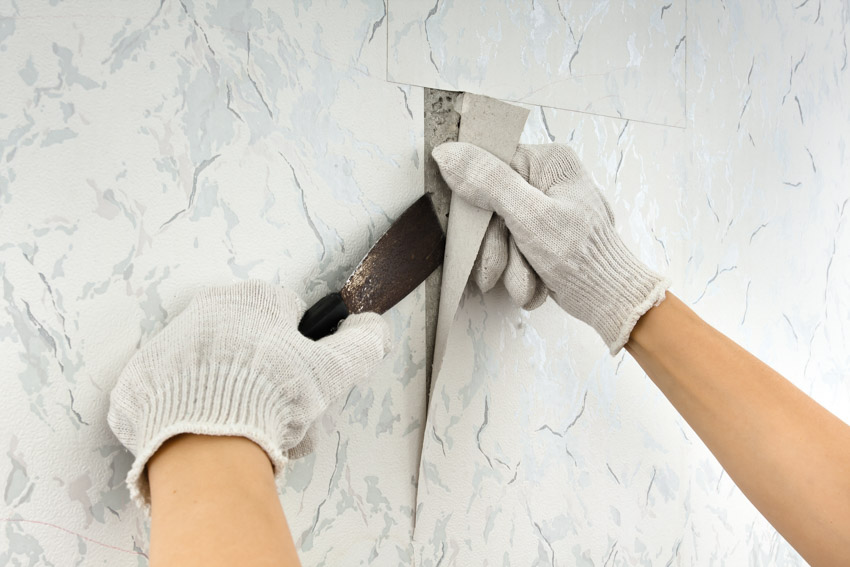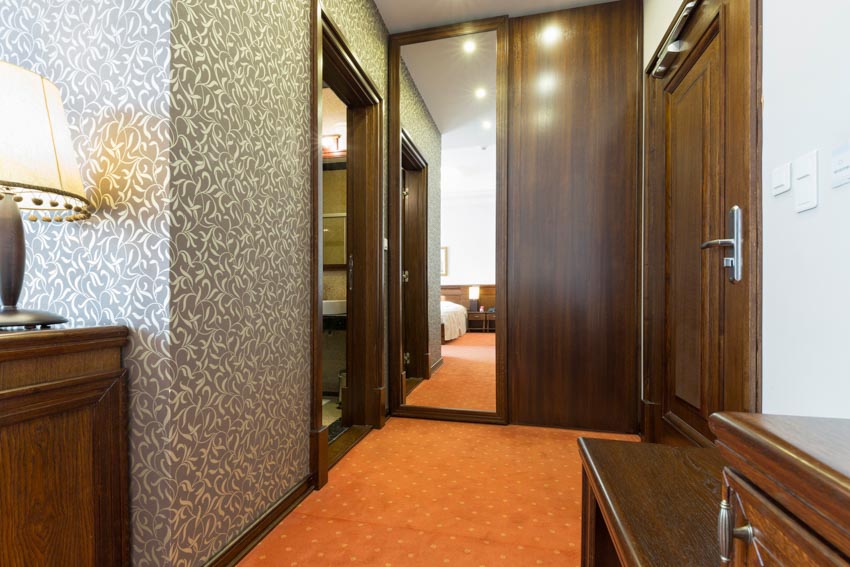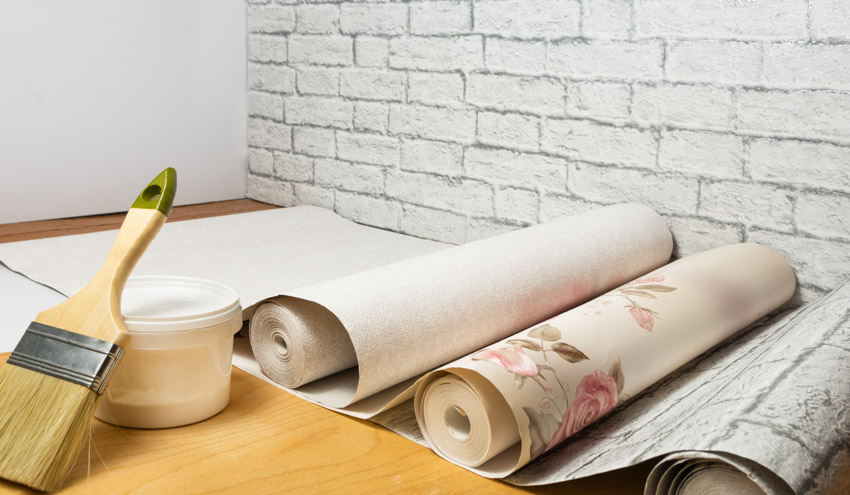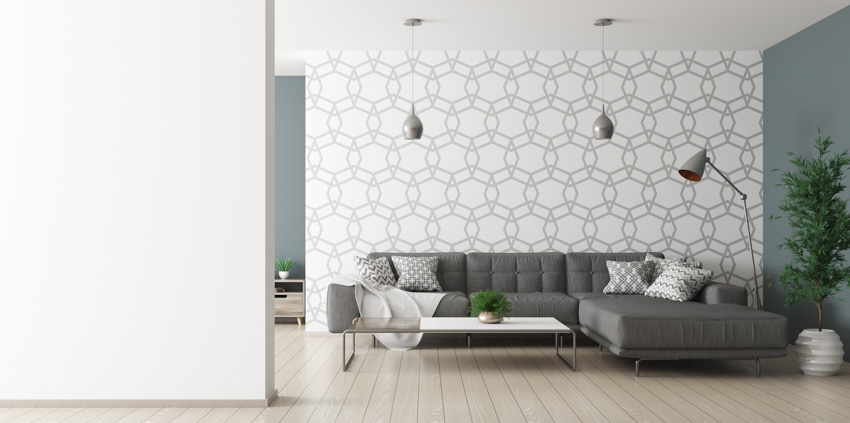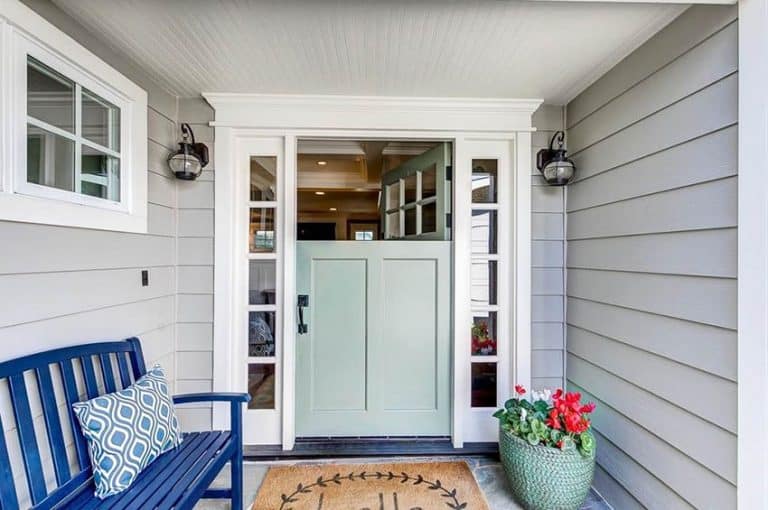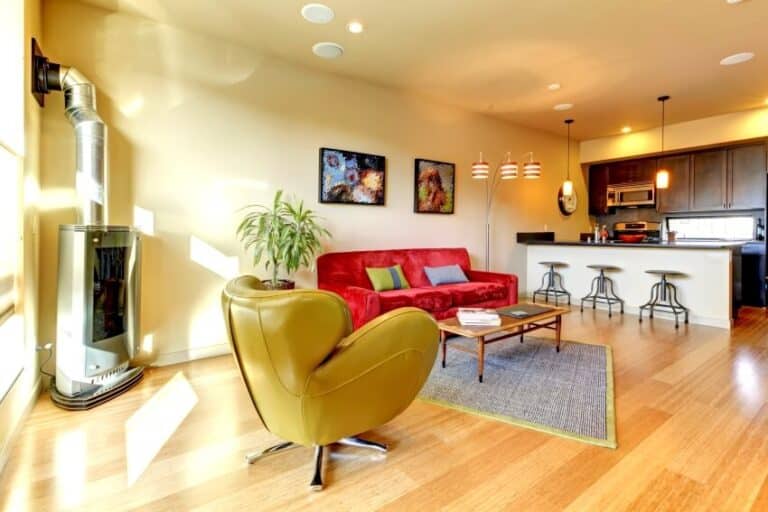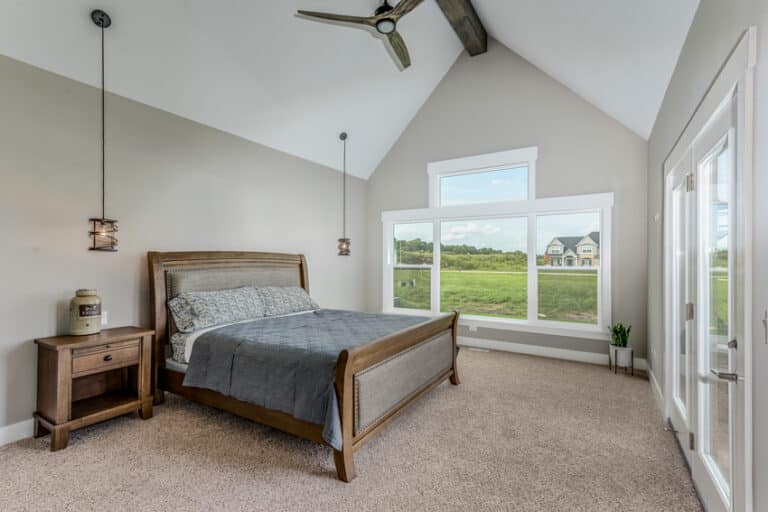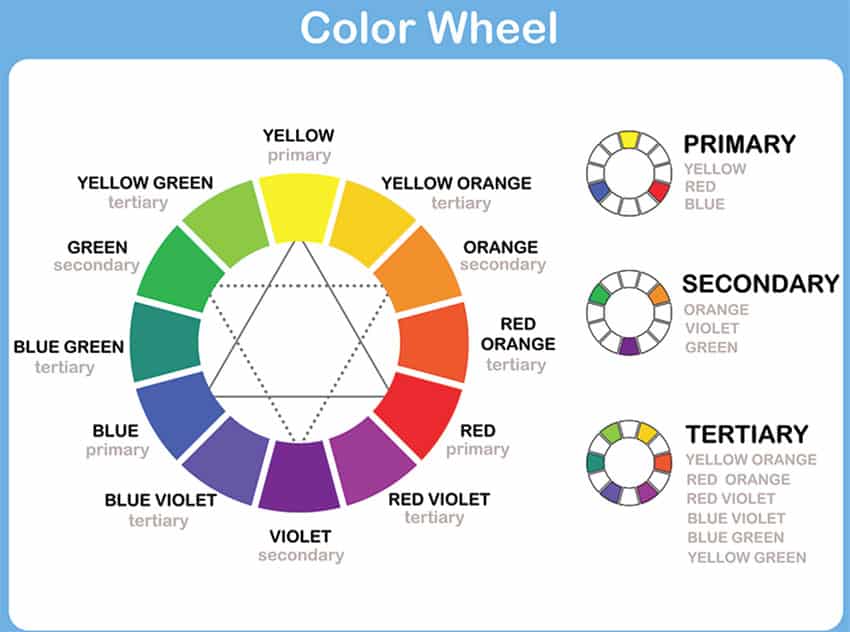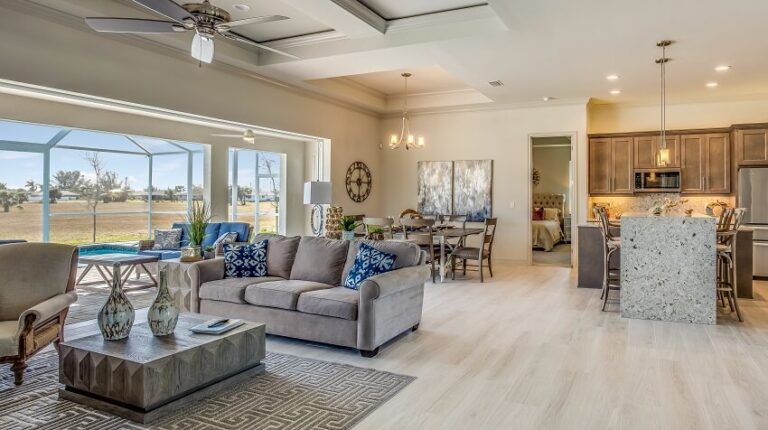21 Types Of Wallpaper (Ultimate Design Guide)
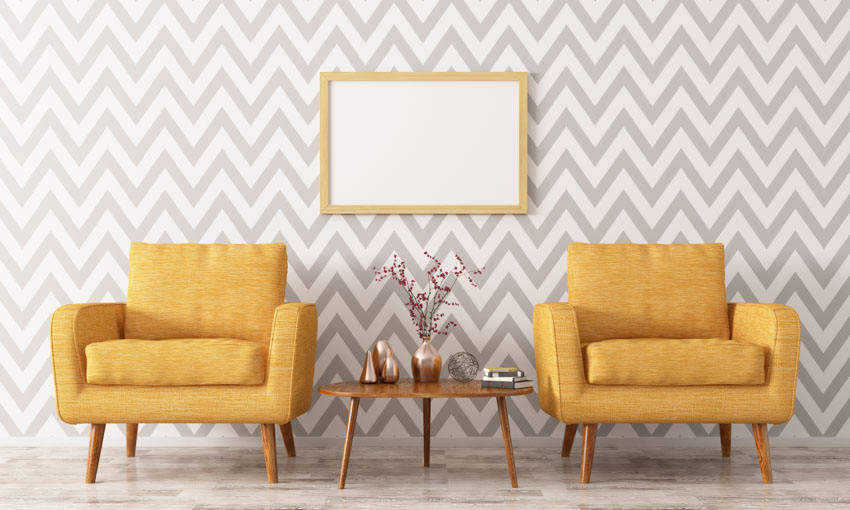
Wallpaper is a very fashionable aesthetic option these days for interior design. Indeed, the comeback of this extremely adaptable and creative wall covering is happening, and it comes with an abundance of new material innovations and designs.
Nowadays, you no longer need to deal with wallpaper that is complicated to install and attach. You can now enjoy a vast array of materials that are all much easier to attach and remove.
You can pick the most ideal style and material for the living space you’re decorating or remodeling, as well as the one that is best suited to your personal design preferences. In this article, we will show you the different types of wallpaper available.
Vinyl Wallpaper
This is a prevalent kind of wallpaper that has a backing layer, a paper layer, and a plastic-made covering on top. Vinyl products are relatively washable, will not fade when exposed to light, and is very affordable and simple to install.
This renders it excellent for spaces where it may be scribbled on or become very dirty, such as the kitchen or children’s playroom.
Nevertheless, vinyl wallpaper has some drawbacks, such as the fact that it does not enable your walls to ventilate and ‘breathe’ efficiently. Certain tests according to the NIH have indicated that old-aged vinyl sheets emit harmful vapors into the house and should be updated every once in a while.
There are three types under the vinyl category – solid, vinyl-coated, and fabric-backed. Let us discuss each one of them:
Solid Vinyl
Solid vinyl wallpaper is made out of pure vinyl. When you encounter the phrase “solid vinyl,” you are looking at the vinyl that tops all types of vinyl.
It is indeed easy to clean, scrape, and it is impervious to scratches. With this basis, numerous individuals place it within their kitchen, bathroom, shower room, and laundry room.
Moreover, solid vinyl is very affordable due to its uncomplicated manufacturing, giving you the greatest value for your money in comparison to various wallpaper alternatives.
But that is not to claim that every solid vinyl coverings are inexpensive. Others have exquisite silk and synthetic fabric patterns that look elaborate and luxurious, despite the low price tag. The majority of solid vinyl products on the marketplace now are prepasted.
Vinyl Coated
The vinyl content of vinyl-coated wallpaper is lower than that of solid-vinyl. It does contain vinyl, but as the name suggests, it is coated onto the paper.
This provides a great balance between non-woven, which is tougher and more long-lasting, and conventional vinyl. Furthermore, vinyl-coated is typically less shiny and more matte than conventional vinyl, but it might still contain a minimal amount of gloss.
Fabric Backed
This is arguably the most durable vinyl wallpaper available, integrating the durability of vinyl and heavy-duty fabric. It can even be found with unique appliques or hand-painted designs for added visual appeal.
When you hear the words “fabric backed,” you may probably assume that it is an industrial-grade material employed in hotels, office structures, major event venues, or airports.
Yes, it is normally seen in such locations as this application cannot be easily scratched or torn. You might also find stenciled or mylar designs in this style.
Although this variant of vinyl is mostly utilized in business settings, countless homeowners also prefer to use it in their houses due to how effectively it works. Aside from that, fabric-backed vinyl is usually prepasted or peel-and-stick, although it can also be non-pasted.
However, the majority of fabric-backed vinyl is available in 30-yard bolts, which might be inconvenient for most people because they will not need that big for a regular-sized room.
Textile Wallpaper
Textile wallpaper is probably one of the most traditional styles of wall coverings. It has kept its presence in interior home décor for ages with a blend of distinct fashion themes.
Textile products are a kind of non-woven wall coverage. It is made up of two layers. The primary layer is made of fabric, while the second layer is made of non-woven material.
Fabric or textile wallpaper is often laminated onto standard types and is, as the name implies, made from textiles. This can be a demanding application to deal with since it must be stretched but not expanded too far that the fabric splits. Furthermore, it is not always simple to keep your fabric surface spotless or to avoid stains from developing.
Moreover, textile designs are available in a variety of colors, patterns, and thicknesses, ranging from extremely informal to exquisitely sophisticated. It is typically manufactured of cotton, linen, genuine botanical fibers, as well as synthetic fibers.
It is frequently glued to a paper backing. Depending on the structure, this paper backed product has the aesthetic appeal of fabric, such as silk, velvet, cotton, or linen.
Textile wallpaper, on the other hand, is classified into two types: natural and synthetic textile. Here are their details:
Natural Textile
This type of textile wallpaper is purely constructed of natural fibers glued to a sheet or acrylic backing. A few of the popular types are linen, silk, hemp, cotton, wool and grasscloth.
These materials offer a natural look and feel and helps minimize the environmental problems associated with some chemically processed types.
Synthetic Textile
The pattern of this wallpaper is similar to that of natural textiles. Synthetic textile interior wall coverings, as the name implies, are composed of synthetic fibers rather than natural materials.
However, these types are more ideally suited for high-traffic locations. This is due primarily to their durability and ease of maintenance.
They are often moisture resistant, available in a wide range of colors and styles and are more affordable for large wall projects.
Non-Woven Wallpaper
Non-woven wallpaper is a mixture of natural fibers and vinyl that is more breathable, versatile, permeable, and long-lasting than traditional paper-backed materials.
This could be the next major upgrade from regular paper backing, but it is not a complete vinyl backing. Certain non-woven wallpaper includes zero vinyl and are constructed entirely of natural and synthetic botanical fibers.
It is designed to go vertically and horizontally in wide flowing sheets when placed on a suitable surface. Glue is required for non-woven backing.
Non-woven wallpaper is a type of premium product. The primary material of this high-end application is composed of organic plant fiber non-woven technology, which has greater tensile power, more environmental preservation, minimal mold and discoloration, and superior air penetration. This quality print is often free of harmful chemicals commonly found in other materials.
Furthermore, non-woven wallpaper has an integrated top and bottom, no paper basis, and uses superior direct printing and color registration innovation. It is more luxurious than regular fabric coverings. It is the ideal mixture of noble and graceful classic patterns and a simple yet attractive modern design aesthetic.
Prepasted Wallpaper
Prepasted wallpaper is often extremely simple to apply, given that you are willing to make a minimal mess and have the necessary tools. After cutting the sheets to the exact size and proportions, leaving a few inches for leeway, you can place it in a large bucket of water.
Prepasted wallpaper comes in three varieties: non-woven, vinyl-coated, and solid vinyl, as previously mentioned.
The adhesive is integrated into the backside of this product. You will not be able to see it on the rear, either visually or physically, unless you activate it by applying water, following the specific instructions provided by the installer.
The water serves as a stimulant, causing the backside to adhere. Several people sprinkle the back with a sprayer or a water container, while others unwind the rolls and immerse each sheet into a water-filled basin.
It is critical to not keep the item immersed in the water for an extended duration since this can allow the adhesive to wash off into the water.
After only a few seconds in the water, the backside of the paper should get extremely sticky. Afterward, just wipe away any excess water that has gathered up in the sheet before attaching it to the wall.
Peel And Stick Wallpaper
Peel-and-stick wallpaper is really simple to set up on your own. You may rapidly and effortlessly mount the paneling or tile to your wall by gently peeling off the backside of the material and putting it somewhere where you want it to be.
Whenever applying this kind of wallpaper, always observe the bubbling left behind since it is possible to develop creases in your surface during the application. Carefully line up the edges and use a squeegee or seam brush to help remove air pockets.
Furthermore, peel-and-stick wallpaper advances one level above prepasted styles. The backing is already adhesive and suitable for use without the need for supplementary gluing or water.
This is intended for customers searching for more temporary alternatives, such as tenants. You can place it and remove it as necessary. It is indeed reusable, especially when they are placed properly in its previous position. Hence, when you remove it, you can re-hang it in a different space.
Grasscloth
Applying grasscloth wallpaper is a great method to add complexity to your walls without having to use clay or additional three-dimensional substances. This style is often quite appealing, will endure a long while, and can frequently be redone.
When you choose paintable grasscloth, you can easily update the appearance of your room without putting in a lot of work. However, this type can also be derived from nature. There are grasscloth wallpapers that are produced from real grasses and dried reeds that are interwoven together on a paper substrate, giving a sense of warmth and natural charm to your room.
This material lends a genuinely earthy aesthetic, texture, and, indeed, scent to a room. They may appear and feel identical to synthetic grasscloth, but natural grasscloth surrounds the space with a distinctive fresh grassy aroma.
Linen Fabric
Linen wallpaper is a worthwhile option for your home. It is more expensive than comparable designs since linen is a premium natural fabric material that provides unsurpassed luxury.
Numerous patterns are hand-woven in small amounts to ensure exceptional quality. Certain designers believe that linen wall coverings are more difficult to apply and remove than synthetic fabrics.
Linen fabric, as opposed to vinyl or vinyl-coated wall covers, are similar to upholstering your wall. Linen gives smoothness and softness that other textiles can only come close to matching.
Thus, when you arrange your overall layout idea, assess if the price matches your budget and analyze the pros and cons of this variety. Moreover, linen fabric creates a wonderful complement to wood grain or colored walls. They can even enhance the dynamics of the room, making them a terrific selection for music studios or bedrooms.
Typical linen wallpaper is normally made of an unpasted woven textile in a specific color, and some can be backed with paper for quicker fastening.
You might be amazed at how much diversity woven linen products have to provide, as well as unique styles that vary from unobtrusive to eye-catching, depending on the colors, weaving, and thickness of the linen fabric.
Paintable Wallpaper
Paintable wallpaper has been ideal if you prefer to incorporate complexity into your home while still having ultimate control over the color scheme. This form is typically patterned and has a recurring motif that will genuinely pop and shine through after being painted with a brush.
You just have to ensure that the paint you select will go nicely with your chosen wallpaper, and take into account the finishing touch so you will not end up with an excessively glossy sheen in your living room or a very hard-to-clean surface.
The ability to customize the color of your wall while still enjoying texture is indeed another wonderful advantage to go with paintable surfaces.
Natural Bamboo
This type is created from pure bamboo and attached to the paper. Because of its natural composition, the color differs from roll to roll.
Nevertheless, it must be handled with care when gluing and attaching because the adhesives might destroy its beauty. Another reason why you should handle it with extra care is that it is not washable.
Bamboo wallpaper is an environment-friendly and entirely natural covering material manufactured from various portions of the bamboo core. Because of their eco-friendliness, bamboo materials do not trigger allergic problems and are completely safe for youngsters.
Hand Screened Wallpaper
Hand-screened wallpaper was established in the 1940s and is a time-consuming process. Humans are involved here, as the name implies. An exceedingly huge paper is put out on extremely long tables in this procedure.
To start this process, a worker sets a huge panel with a pattern facing down on a sheet of massive paper. The worker then pours water-based ink onto the backside of the panel and employs a rubber-made squeegee to drive the ink into the spots where the mesh lets ink flow through the paper. Before applying the next color, each layer of this must dry first.
As you might expect, this is a highly-skilled, intricate, and time-consuming procedure, but the result is wallpaper with a rich-quality texture and overall design thanks to both the substantial layer and the meticulous distribution of the ink.
As a result, the colors are bold, distinct, and extremely rich. The designs have strong, precise borders and complexity, and the paper is quite flawless with a small surface edging.
Embossed
Embossed wallpaper is dense and heavily textured, but it has a colored design rather than a plain backdrop. It is raised on one side for decoration and hollowed on the other.
Embossed wallpaper offers depth to a wall and can conceal a variety of flaws, such as bumps, gaps, scrapes, scratches, and uneven surfaces.
Aside from that, the embossed style appears great with a faux-effect layout, including brick or stone, since the textured pattern gives the paper a 3D appearance.
When you choose embossed wallpaper, you will, without a doubt, receive a robust and durable product that is easy to attach, making it a favorite selection among homeowners.
Flock Wallpaper
Flocked wallpaper is an excellent technique to add ornamental elements to your house or a particular space. This paper is velvety to the feeling and features an embossed velvet patterning on it.
When installing flocked materials on your house walls, you must vacuum any residual flock grains off the surface ensuring that they do not interfere with a flawless and uniform finish.
Cleaning flock is typically safe as long as you exercise caution, as hard washing can harm the surface. Routine maintenance such as periodic dusting and avoiding touching the walls can help minimize the need for time consuming deep cleaning tasks.
Foil Wallpaper
Foil wallpaper is a metallic overlay that is used to cover a wall. It is made by adhering a thin layer of metallic foil to a substrate of paper. On the upper part of the metallic surface, a design is imprinted. Gold, silver, and copper are the most common colors.
There are several types of foil wallpaper or metallic products commercially offered, including silver metallic, gold foil, gray metallic, and bronze foil.
To give your interior space a dazzling metallic impression, a polished metal foil can be utilized as a substrate for your walls. Unfortunately, because of its great reflectivity, foil draws attention to flaws in the wall.
As a result, the base wall must first be refurbished, treated, or protected with lining paper. The lining and attaching technique must be clean and organized enough to avoid degrading the reflectivity and brightness of the foil.
Liquid Wallpaper
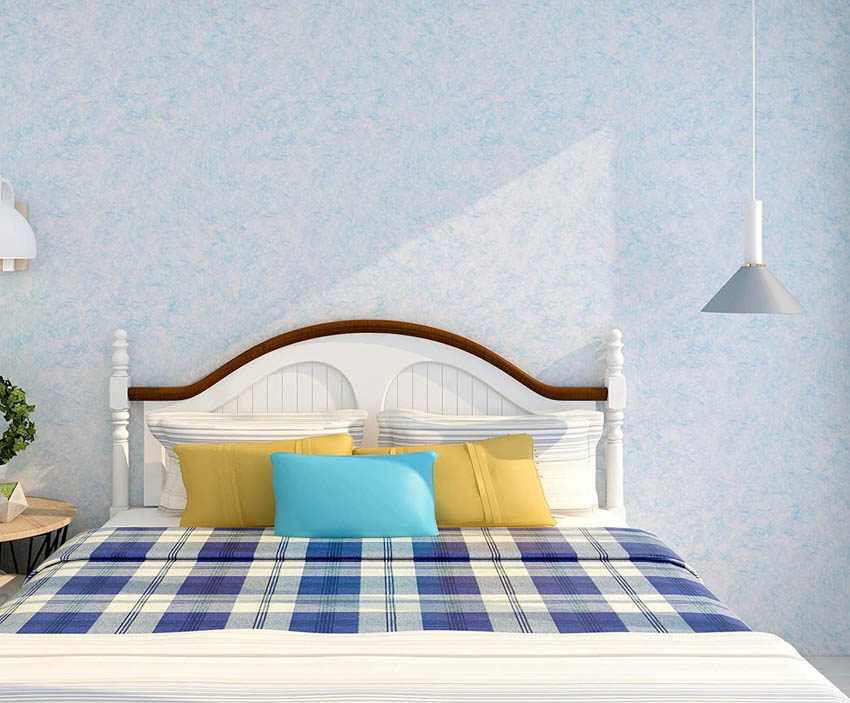
Liquid wallpaper is a type of ornamental plasterboard. Such applications are available in both dry and liquid forms, but the dry ones are more frequent. The cost of packed liquid wallpaper will vary according to the supplier, the formulation of the solution, and the type of filler used.
The dry-type mixture is blended with regular water and placed on the wall with a spatula or a trowel, much like other varieties of finishing plasters. The ultimate product is a lovely, eco-friendly ornamental covering that is warm and coarse to the touch and has great heat and noise shielding capabilities.
Do-it-yourself liquid wallpaper would be simple because the composition incorporates the production of paper. There are also complete guides and tutorials available online about how to attach it.
Liquid wallpaper is a relatively affordable finishing medium, and because it does not require a completely flawless wall before application and it does not necessitate huge expenses in preparation. It can also be put straight to the plaster. However, in order to achieve a high-quality result, surface preparation should be carried out.
Lining Wallpaper
Lining wallpaper is a type of wall coating that is used to prep a wall for adornment before installing another wallpaper or paint. Lining has numerous advantages.
Its primary function is to conceal any faults on the wall beneath, resulting in a flawless canvas that appears beautiful when entirely painted.
It also improves your energy efficiency, which is a nice bonus. It traps heat by adding a layer underneath your wallpaper, significantly increasing your home’s thermal insulation and noise barrier.
Aside from that, lining can also be employed to conceal ceiling problems. It will cover any wear and tear, from small cracks to collapsing plaster, and make it a lot easier to paint or cover.
Nevertheless, be certain that the damage is only on the surface – you would not want to neglect internal structural damage that could worsen any time soon.
Murals & Photo
Adding murals and photos to your walls is the quickest way to extensively cover a wall and add visual appeal to your house.
When purchasing murals and photos, be certain that the style and size will not overshadow your area, as they are typically very huge. Murals in a range of designs and colors that complement your home’s décor are readily available.
When searching for a mural or photo, take into account how easy it can be uninstalled as you may grow tired of having a huge design work in your home. Being able to remove the mural without issue will make it easy to update it with a new appearance just in case you change your mind.
Most Popular Wallpaper Styles
Wallpaper with Metallic Accents
Metallic wallpaper is a great way to make a room stand out and add a touch of something special to your area.
This will make it appear as if you hired a professional designer to come into your house or workplace and paint your walls for you, rather than merely hanging up fresh wall coverings.
If you select metallic wallpaper, you can apply it on most of the walls in your room for optimum appeal, or you can utilize it as an accent wall to bring emphasis to a specific area in your room.
Free-Matching Wallpaper
This is the simplest type to install since no matching is necessary. It makes no difference how you arrange your wallpaper strips, what sort of drop you possess, or if you balance the strips because there will be no gaps or obvious connections to worry about.
Thus, when you place your lining paper, this sort produces the smallest amount of litter.
Minimalist Dramatic Graphics Wallpaper
Interiors that draw inspiration from basic geometric patterns, subtly raised texture, and monochrome colors express the solace found in pattern and consistency.
Wallpaper with minimalist dramatic graphics are becoming increasingly popular nowadays as they provide your space with a peaceful and relaxing ambiance.
You can also put material with oversized, artistic patches, each somewhat different and identified by its designer’s hand, hinting movement in minimalistic shapes as if they are subtly wandering around each other.
You may blend all of the neutrals and natural tones to create a simple yet dramatic effect, naturally coordinating with each other and gliding flawlessly into your white or beige living room or bedroom.
Textured
Textured wallpaper can be used in any house or workplace to generate an eye-catching wall that will attract the interest of anybody who enters.
This is a low-cost approach to alter the aesthetic of your house or workplace without employing a professional to texture your walls for you.
Moreover, textured wallpaper is quite adaptable and can conceal a variety of flaws in your wall so that no one knows if there are cracks or holes in the wall. Furthermore, textured applications are a simple way to add aesthetic appeal to your walls.
Repositionable
When attaching wallpaper, it can be quite stressful and discovering that you made errors with installation. However, with repositionable wallpapers, you can effortlessly rectify your mistakes without bothering to tear the old material out and damage it.
Positionable wallpaper allows you to easily slide it over to conceal a flaw, line it up with one panel, or fit flawlessly against a cabinet or door.
Furthermore, when you use positionable products in your house, you can do the wallpapering process more easily by yourself.
Peel-and-Stick Wallpaper: Peel-and-stick is the best option for people who want to easily alter their décor without committing to anything more permanent. In fact, that is what makes it one of the most popular wallpaper styles.
If you enjoy modifying your décor from time to time to change the overall style of your room, you will appreciate how easy it is to apply peel-and-stick wallpaper to transform a full room or an accent wall to fit your fancies.
They are perfect for staging houses when a temporary appearance is required until the house is purchased.
What Is The Standard Wallpaper Size?
Wallpaper is often printed and manufactured in three standard widths: 21 inches, 27 inches, and 42 inches. These are the standard wallpaper sizes used in the market.
Depending on the width, a single roll of wallpaper generates around 50 square feet of useful paper.
Wallpaper is sold by the manufacturer in packaged roll and is normally 57 square feet in size. Certain products, particularly from America, are around 70 to 72 square feet in size.
You can use approximately 55 square feet of the roll for conventional wallpaper designs. Because of wastage in coordinating design patterns, it might cover up to 50 square feet from the roll for flowery or other complex patterns.
Wallpaper Cost
The cost of wallpaper is determined by the type of product purchased. On average, basic wallpaper costs $25 to $50 a roll.
However, designer and customized products can cost up to $5,000 per roll. Because one roll of wallpaper covers around 30 square feet, you can expect to pay between $1 and $3 per square foot.
Wallpaper Prices in a Nutshell:
• Average Cost Per Roll (Basic) – $25 to $50
• Average Cost Per Square Foot – $1 to $3
• Average Cost of Installation Per Roll – $30 to $65
• Average Cost of Customized or Designer Product Per Roll – $1,000 to $5,000
Pricing is also affected by the type of paper you select. Here are some examples of common wallpaper styles:
• Standard Paper – around $1.25 to $2
• Vinyl – around $1.75 to $3
• Vinyl-Coated – around $1.70 to $2.75
• Foil – around $2.05 to $3
• Grasscloth – $2.40 to $3.5
If you require numerous coats, painting a room will still be a bit less expensive than wallpapering it. Labor costs are also reduced in this way.
You can apply a fresh coat of paint over your existing paint, but when it comes to putting wallpaper, you must first remove the old wallpaper before putting up new. This raises the overall cost as well.
The total cost is primarily determined by the materials used. In several cases, it might be less costly to apply wallpaper instead of adding a finishing touch using a customized paint job. Here are some of the factors that might affect the cost of your wallpaper-attaching project:
• Dimensions of the Area You Want to Wallpaper: The larger the space or wall you wish to wallpaper, the more material you will need to cover it. Meaning, the cost will surely drive up. You will have to perform some measuring to figure out how much you will need to apply.
Determine the square footage of the area that will be covered. Measure the length and width of each wall that will be wallpapered. Multiply those measurements to determine the wall’s surface area in square feet. Calculate the surface area of each wall.
Following that, you must measure each window, door, and other places that will not be covered. Subtract the surface area of the areas that do not need to be covered from the overall size of the wall.
Lastly, add 10% to the cost to accommodate for properly cutting and lining up wallpaper. If you are covering a wall with a surface size of 80 square feet, for instance, you must add 10%, or 8 square feet, to your total. You will need at least 88 square feet of wallpaper in total.
• The Type or Design of Wallpaper You Will Buy: Costs may differ depending on what is imprinted on the paper. 3D wallpaper, for instance, is more expensive than products with plain or conventional patterns.
You should also take into account how difficult it will be to coordinate the wallpaper. If you want to line up the paper with a certain graphical design or anything like stripes, you might have to buy more material.
• Getting the Walls Ready: It is possible that you will need to remove your current wallpaper from the walls or prepare the walls by fixing small gaps and fractures. This necessitates the use of additional materials, which might raise the overall cost of the project.
• Employing a Professional to Install Wallpaper: If you hire someone to do the project instead of doing it yourself, the overall cost might increase substantially. Specialists can charge up to $60 to apply a single roll. The more preparation work and specific trimming that is required, the greater the cost.
What Is The Average Cost To Remove Wallpaper?
The majority of homeowners are more likely to spend around $420 to $1,200 (average of $750 to $780), on wallpaper removal. The approximate cost of removing wallpaper is $3 per square foot in labor and $100 in supplies, for a total cost of $535 for a 12′ x 12′ space.
For the same size room, the cost might vary from $135 to $1,550 depending on considerations such as the total count of layers, condition, type, and accessibility.
A space can be transformed from uninteresting to gorgeous with new wall coverings. However, before you decide on the best way to remove your old wallpaper, consider the following factors:
• The type of wallpaper you wish to put to update your walls
• The condition and age of your existing wall covering
• Number of wallpaper layers
• The height and width of your walls as well as the irregularity caused by your stairwells
• The damage that could occur to the underlying walls during the wallpaper removal process
If you are going to hire an expert for wallpaper removal, he or she will create a quotation based on the size and type of room.
Areas with vaulted ceiling design types, for instance, may necessitate the use of scaffolding or customized ladders, which would raise the cost. The expert will also look at the type of walls and the number of pieces of wallpaper to establish the rate per square foot.
Take into account that if the expert discovers something unplanned after starting, including the presence of extra layers or non-primed drywall, the per-square-foot cost may increase because the number of hours of labor will increase as well.
Which Is Better: PVC Or Wallpaper?
PVC (vinyl) wallcoverings have a coating of polyvinyl chloride (PVC). Although some vinyl wallcoverings have a paper substrate or a fabric backing, they are indeed regarded as a very durable yet low-maintenance wallcovering option due to their vinyl surface.
This type of wallcovering is intended to meet particular physical performance criteria, making it more appropriate for high-traffic areas. It is long-lasting and simple to clean.
Moreover, PVC wallcoverings come in an enormous variety of textures, colors, and designs, ranging from tactile fabrics and geometric patterns to surfaces designed expressly to be tough and hygienic. They are often sold as tile pieces (square or rectangular).
The benefits include flame-resistance properties, sustainability, light and color stability, clean-ability, durability, ease of installation and maintenance, resistance to scratches and impact, prevention against stains and chemical products, and a life expectancy of up to 15 years.
On the other hand, standard wallpaper is also long-lasting and can last for more than 15 years, making it an extremely cost-effective option. When correctly installed, wallpaper can last three times longer than paint. If your walls are uneven, high-quality wallpaper can conceal surface flaws. They are frequently offered in rolls.
Wallpaper is available in a huge range of designs, as well as a vast array of textures and patterns. Flocked, metallic, embossed, and other textures are available.
Wallpaper application is not messy, and there is little to no chance of getting splatters on your furniture or ground. If you have kids or pets, you will not have to worry as most wallpapers can be easily wiped off, just in case there are stains that need to be cleaned.
However, here are further details about which is the better option in terms of different categories:
• In Terms of Moisture and Heat Resistance: PVC (if placed correctly)
• In Terms of Ease of Installation: Wallpaper
• In Terms of Affordability: Wallpaper (Depends on the Type)
What Kind Of Wallpaper Is Easiest to Apply?
Peel-and-stick wallpaper is, without a doubt, the easiest to apply among all types of wallpaper. Today’s peel-and-stick wallpapers provide plenty of options for decorating a rental space or most types of rooms in a house.
This versatile material is primarily made out of vinyl and has an adhesive backing. It can be applied to a variety of wall surfaces and will not ruin them when removed.
Unlike conventional prepasted papers, which require wetting the pasted backing to adhere and cannot be removed without unpleasant stripping, peel-and-stick wallpaper is exactly what their name implies. You peel off the backing before sticking them to the wall.
There is no need for water, a smoothing brush, or a sticky paste, and whenever you are ready to remove it, you can easily pull each piece away from the wall, keeping the surface undamaged.
Which Wallpaper Type Is The Best?
Vinyl wallpaper is by far the most durable and best type available. When compared to paper-based and non-woven wallpaper, it can withstand a beating and continue to function.
Vinyl wallpaper is a greater option than other types since it is structurally sound, and does not have a plastic feeling to it. The majority of vinyl wallpaper patterns are comparable to non-woven patterns. It is machine washable and suitable for use in bathrooms and kitchens.
Furthermore, because vinyl consists of high-quality materials, it is more resistant to fading, tears, and holes. Read more about our guide on wallpaper vs paint here.

